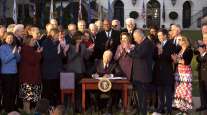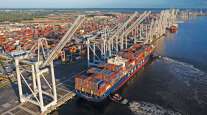Senior Reporter
Biden Executive Order Calls on Agencies to Prioritize 'Environmental Justice'

[Stay on top of transportation news: Get TTNews in your inbox.]
A sweeping executive order from President Joe Biden calls for a review of all Trump-era environmental regulations with a focus on the issue of “environmental justice,” an effort to cut greenhouse gas emissions in low-income and minority communities across the United States that, in many cases, are located near where heavy trucks operate.
The edict appears certain to heighten pressure on the trucking industry to continue efforts to reduce oxides of nitrogen, particulate matter and GHG levels, especially in areas that have long complained of negative health impacts from pollution near areas where trucks operate, according to Glen Kedzie, energy and environmental affairs counsel for American Trucking Associations.
“The policy is sprinkled into everything this administration is going to do,” Kedzie told Transport Topics. “Our industry needs to get to know the term. We frequent ports, rail yards, warehouses and inner cities as part of our conducting business.”

Kedzie
Kedzie notes that trucking has long embraced efforts to reduce heavy trucks’ carbon footprints through sustainability efforts like the Environmental Protection Agency’s SmartWay program. The industry also has worked to comply with federal and state regulatory efforts that date back to 2007, as well as EPA’s Phase 1 and Phase 2 GHG regulations, he noted.
Still, he said Biden’s environmental policy is going to be a “big thing for us.”
The language of the Jan. 27 executive order promises to hold accountable sources of pollution that, “disproportionately harm communities of color and low-income communities.”
“The federal government has failed to meet that commitment in the past, it must advance environmental justice,” the executive order said.
Kedzie said it behooves trucking to be an active participant, as the decree gives the administration wide leverage over stationary and mobile sources of pollution and energy production.
“If we don’t do it voluntarily, the administration is going to do it through regulatory and mandatory measures,” Kedzie said.
One primary way EPA and state environmental officials could target emissions reductions is through adoption of electric vehicles. California environmental regulators already have directed manufacturers to sell a certain percentage of zero-emission trucks there beginning in 2024, with the goal of all trucks being nitrogen cell or electric by 2045.
The California Air Resources Board has created an executive position specifically to oversee environmental justice efforts.
“The roots of environmental justice stem from environmental racism,” Chanell Fletcher, deputy executive officer for environmental justice at CARB, said in a statement to TT. “CARB is committed to continuing to work with communities, local agencies and federal agencies, to ensure that combating climate change also includes fighting for those most and worst affected by air pollution. This means not just investing in disadvantaged and low-income communities, but actively ensuring a seat at the planning table for these communities.”
Last summer a bipartisan group of governors from 15 states and the District of Columbia signed a memo of understanding committing to zero-out toxic air pollution from new medium- and heavy-duty truck and bus sales by 2050. One of those states, New Jersey, has since opted out of the agreement and announced plans to enact an electric truck and bus rule in April.

Jimmy O’Dea, senior vehicles analyst for the Union of Concerned Scientists, said UCS research has shown that Asian-Americans are exposed to harmful pollution 34% more than the national average, with 24% of African-Americans and 23% of Latinos exposed more than the national average.
“The trucking industry as a whole definitely needs to acknowledge its role and come to the table and be part of the solution, because — ultimately — trucks aren’t going away,” O’Dea said, and urged the White House to focus more on a transition to zero-emission technologies. “There hasn’t been a lot of federal action to date on electric trucks in particular,” he said.
Environmental group GreenLatinos said trucking needs inducements to help propel wider adoption of zero-emission technology.
“I think that the major issue with the trucking industry is that there are no incentives,” said Andrea Marpillero-Colomina, clean transportation advocate at GreenLatinos. She noted that the industry will keep driving fossil fuel trucks for as long as possible — based largely on business reasons — until they’re compelled to change. But she questions the wisdom of forcing that change.
“I don’t think it is going to be effective,” she said. “It’s not going to win any allies to point fingers at the trucking industry and say ‘You guys are just responsible for this.’ ”
“There needs to be close collaboration between the state regulatory agencies and motor carriers so there can be a lot of back and forth in terms of what’s needed,” said Patricio Portillo, transportation analyst at the Natural Resources Defense Council, an environmental nonprofit.
Mike Tunnell, ATA’s California-based environmental researcher, noted that trucking has already made great strides with clean air initiatives. “The industry has come a long way in the last decade or so, and we’ll see how the [EPA’s] Clean Trucks Initiative will play out. Then the question becomes how much is enough? At the end of the day if you end up with an all-electric fleet, does this issue go away, or is it really a matter of trucks in your neighborhood?”
He added, “It sounds like the administration is making environmental justice a priority with trucks operating in or near some of these communities. That will definitely be looked at as a potential source of emissions. I think we can expect more activity in this area.”
Want more news? Listen to today's daily briefing below or go here for more info:





